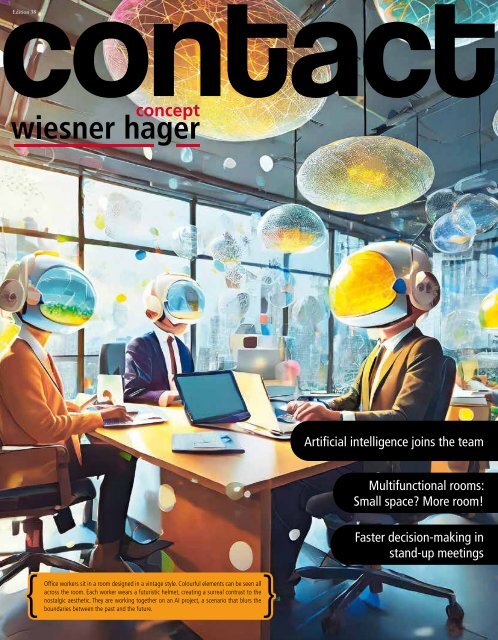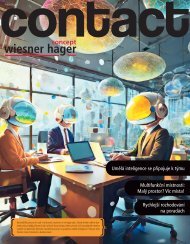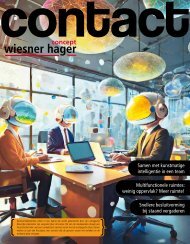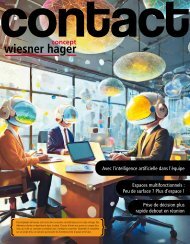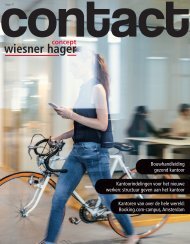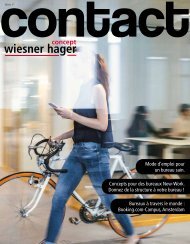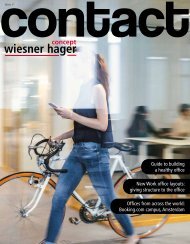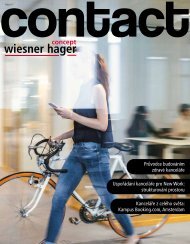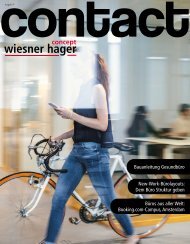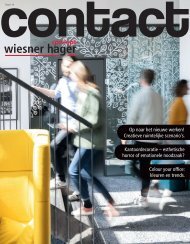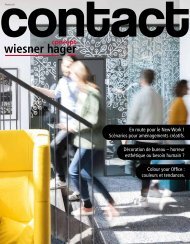contact_office_magazine_#38_EN
Welcome to the latest issue of contact – your trusty companion through the ever-evolving world of work. In this issue, we’re focusing on the topic of artificial intelligence and its influence on office working. Is AI nothing more than a nice assistant, or will it soon become a colleague?
Welcome to the latest issue of contact – your trusty companion through the ever-evolving world of work. In this issue, we’re focusing on the topic of artificial intelligence and its influence on office working. Is AI nothing more than a nice assistant, or will it soon become a colleague?
You also want an ePaper? Increase the reach of your titles
YUMPU automatically turns print PDFs into web optimized ePapers that Google loves.
Edition 38<br />
Artificial intelligence joins the team<br />
Multifunctional rooms:<br />
Small space? More room!<br />
Faster decision-making in<br />
stand-up meetings<br />
Office workers sit in a room designed in a vintage style. Colourful elements can be seen all<br />
across the room. Each worker wears a futuristic helmet, creating a surreal contrast to the<br />
nostalgic aesthetic. They are working together on an AI project, a scenario that blurs the<br />
boundaries between the past and the future.
AI: Your next teammate?<br />
Welcome to the latest issue of <strong>contact</strong> – your trusty companion<br />
through the ever-evolving world of work. In this issue, we’re focusing<br />
on the topic of artificial intelligence and its influence on <strong>office</strong><br />
working. Is AI nothing more than a nice assistant, or will it soon<br />
become a colleague?<br />
Artificial intelligence joins the team04<br />
Small space? More room!07<br />
All about modern coworking landscapes10<br />
What <strong>office</strong> workers really want12<br />
Reference story: Agilox – Doubling down on New Work13<br />
Faster decision-making in stand-up meetings16<br />
Offices from across the world: Casa Pich i Pon, Barcelona18<br />
What's on your desk, Carla Lo?21<br />
Trendwatching: Useful ideas for everyday <strong>office</strong> life22<br />
From a meeting marathon to a gentle stroll23<br />
7 <strong>office</strong> must-haves24<br />
Showroom: Agile assistants for modern creative spaces26<br />
We’ll take a closer look at a variety of room concepts that are<br />
designed to meet the growing demand for flexible working<br />
environments.<br />
You’ll find out what <strong>office</strong> workers really want, and discover the<br />
trends you can use to create the perfect <strong>office</strong> environment for<br />
them. From stand-up meetings to real <strong>office</strong> must-haves, this<br />
edition has it all.<br />
And of course, we’ll continue our journey through “Offices from<br />
across the world”, this time heading to Barcelona to explore Casa<br />
Pich i Pon. With a blend of fascinating architecture and an ingenious<br />
<strong>office</strong> concept, the designers have created a truly inspiring<br />
place to work.<br />
So sit back, relax, and immerse yourself in a world of inspiration:<br />
Enjoy!<br />
Laura and Markus Wiesner<br />
© muzivcesku © Petr Karšulín<br />
Publisher: Wiesner-Hager Möbel GmbH, Linzer Strasse 22, A-4950 Altheim, T +43/(0)7723/460-0, altheim@wiesner-hager.com, www.wiesner-hager.com,<br />
thinknewwork.com; concept/editor: Wiesner-Hager, mintmind Communication GmbH; layout: mintmind Communication GmbH, guest author: Wojciech Czaja;<br />
typing and printing errors reserved; 05/2024.<br />
<strong>contact</strong> 3
Office Concepts<br />
4 <strong>contact</strong><br />
AI at the next desk?<br />
Artificial intelligence joins the team.<br />
{Hi ChatGPT! Please write an article about artificial intelligence in the modern working environment.}<br />
It probably would have taken us less than five minutes to enter this command into perhaps the world’s<br />
best-known generative AI tool and get an article about artificial intelligence and New Work back, ready<br />
to print. But is that really the future of the world of work? Where is AI going to be used, or perhaps<br />
even take over? What are the risks? And are we going to become something more akin to colleagues?<br />
Office workers sit in a room designed in a vintage style. Colourful elements can be seen all across the room. Each worker wears a<br />
futuristic helmet, creating a surreal contrast to the nostalgic aesthetic. They are working together on an AI project, a scenario that<br />
blurs the boundaries between the past and the future.<br />
AI research – the status quo.<br />
Almost all of us see the rapid development in the<br />
field of AI as something unfamiliar and unusual. Up<br />
to now, digital- and machine-based support in our<br />
working environments has been limited to assistance<br />
systems – the actual implementation and decisionmaking<br />
still left to us humans. Artificial intelligence<br />
systems, on the other hand,<br />
are becoming more and<br />
more far-reaching, working<br />
largely independently of us,<br />
and generally only requiring<br />
human intervention<br />
as the exception, rather<br />
than the rule. AI enables<br />
machines to imitate human<br />
cognitive abilities – such as<br />
logical thinking, learning<br />
and planning – by recognising<br />
and analysing the<br />
data it is fed and drawing<br />
conclusions from it. It is<br />
therefore not “intelligent” in a human sense, and cannot<br />
magically acquire a human level of understanding;<br />
the data AI works with is provided by humans,<br />
after all. At a base level, it’s all a matter of statistics.<br />
But where are we with AI research at the moment?<br />
Markus Manz and Lukas Fischer from the Software<br />
Competence Center Hagenberg know the answer.<br />
“Research in the field of artificial intelligence is<br />
diverse, dynamic, and revolutionising a huge range<br />
of sectors and roles, including pattern recognition,<br />
forecasting, selection processes, chatbots and medical<br />
technology. Deep learning and neural networks<br />
– both sub-domains of artificial intelligence<br />
– are dominating here. Advances<br />
in the neural network architectures<br />
have revolutionised some areas of<br />
application, such as image recognition<br />
and language processing. As<br />
well as exploring new opportunities,<br />
researchers are also concentrating on<br />
making AI systems more robust, reliable<br />
and adaptable”, says Manz.<br />
AI is particularly suited<br />
to tasks that are<br />
repeatable and require<br />
large volumes<br />
of data.”<br />
AI joins the team.<br />
What exactly does that mean for the world of work,<br />
and where can we make best use of artificial intelligence<br />
systems? “AI is particularly suited to tasks that<br />
are repeatable and require large volumes of data. Making<br />
decisions based on complex facts, and the ability<br />
to react to changes, are also areas where AI shines”,<br />
explains Fischer. But it’s not<br />
suited to every task. “Creativity,<br />
emotional intelligence<br />
and deep interpersonal<br />
communication are all areas<br />
where AI is (currently)<br />
lacking”, adds Fischer. If<br />
artificial intelligence is used<br />
to process complex data or<br />
perform repetitive, routine<br />
tasks, teamwork is essential<br />
– just as it is between<br />
human colleagues. “For<br />
humans and AI to develop<br />
a successful working<br />
relationship, there needs to be a clear assignment of<br />
roles, transparency, explainability, feedback loops,<br />
continuous learning, trust, and consideration of<br />
ethics and responsibility. If these basic principles<br />
and proven methods are adhered to, humans and AI<br />
can solve complex problems together”, says Manz,<br />
confidently.<br />
Dangers and risks.<br />
As much as AI can support and simplify our<br />
working lives, critics are constantly voicing their<br />
concerns about the dangers and risks. “There are<br />
clearly some potential dangers to be aware<br />
of when working with AI. Risks such as<br />
bias (stereotyping) and discrimination,<br />
loss of jobs and social inequality,<br />
security and data protection.<br />
There is also a potential loss<br />
of control, and many ethical<br />
questions. It’s already making<br />
our lives easier in some areas to<br />
such an extent that we could start<br />
to lose certain skills down the line”,<br />
warns Manz. The fear of losing jobs<br />
is a particularly hot topic right<br />
now. “It’s a justified concern, and<br />
the question needs to be asked.<br />
History shows that technological<br />
developments can lead to a<br />
loss of jobs in certain<br />
<strong>contact</strong> 5
Office Concepts<br />
Office Concepts<br />
sectors. However, it also shows that new ones are always<br />
being created. And that’s what will happen with AI. It’s<br />
important to take potential impacts on the job market<br />
seriously and put appropriate measures in place to get<br />
the most out of the opportunities AI affords us”, explains<br />
Fischer.<br />
Explainability and ethics are becoming increasingly<br />
important as AI starts to permeate our daily lives. The<br />
systems have to become more transparent and interpretable<br />
to ensure that AI decisions are traceable and ethically<br />
justifiable. “To this end, as part of the EU’s Digital Strategy,<br />
the EU Commission has put the Artificial Intelligence<br />
Act (AIA) in motion; a law that – in its current version<br />
– contains specific recommendations as to how research<br />
institutions and the wider business world should use AI”,<br />
explains Manz.<br />
Effective collaboration? Ethical problems? Critical<br />
voices? Where do the experts land when it comes to<br />
collaboration with artificial intelligence systems in the<br />
workplace? “The fact is that a team of people working<br />
with AI delivers better results than the most talented<br />
people or most advanced algorithms alone. At the end of<br />
the day, whether we take advantage of artificial intelligence-based<br />
support in day-to-day working life depends<br />
on the specific requirements and objectives of a task, and<br />
the available resources and limitations. And, in the end,<br />
that can only be decided by a human.”<br />
About Software Competence<br />
Center Hagenberg GmbH<br />
The Software Competence<br />
Center Hagenberg (SCCH) is<br />
a non-academic research centre<br />
that has built up a reputation<br />
for outstanding applicationoriented<br />
research in the fields of data and software<br />
science over the past 25 years. This focus<br />
enables it to effectively implement projects in<br />
the fields of digitalisation, Industry 4.0 and<br />
artificial intelligence. The SCCH sees itself as<br />
an interface between the international research<br />
community and the domestic economy, and<br />
carries out world-leading research with its<br />
130-strong team.<br />
www.scch.at<br />
Markus Manz is the CEO of<br />
the SCCH and is responsible<br />
for the institution’s strategic<br />
planning. He wants to further<br />
expand its collaboration with<br />
the scientific and economic<br />
community, and increase the<br />
centre’s visibility on the global<br />
stage as a world-leading institution.<br />
Lukas Fischer is the SCCH’s<br />
Research Manager for Data<br />
Science, and has many years<br />
of experience in research and<br />
project management.<br />
©Nicky Webb<br />
Space to communicate:<br />
Small space? More room!<br />
Increasing communication needs meet limited space: Does this sound familiar? Multifunctional room<br />
concepts are a smart solution when there is not enough space, because they are designed for multiple<br />
use. A flexible furnishing and media concept allows different applications to be implemented in the<br />
same space with little effort.<br />
6 <strong>contact</strong><br />
<strong>contact</strong> 7
Office Concepts<br />
The role of the <strong>office</strong> is fundamentally changing.<br />
While spaces for focused work are becoming smaller<br />
with people increasingly working from home or<br />
remotely, the need for communication zones is<br />
growing. The <strong>office</strong> is becoming more of a space for<br />
collaboration, creative communication, and training<br />
and education. Often, the existing space cannot keep<br />
pace with these new scenarios. The solution lies in<br />
multifunctional rooms, which require a great deal of<br />
planning consideration to work effectively.<br />
One space, many use cases.<br />
Obviously, companies can’t provide a separate<br />
room for every single communicative situation. But<br />
certain scenarios can be effectively combined in<br />
multifunctional rooms, particularly all the various<br />
kinds of training sessions: seminars, courses, lectures,<br />
presentations and workshops, etc. To facilitate this<br />
multi-use concept, the room needs appropriately<br />
flexible space, furniture and media concepts.<br />
Provided there is sufficient<br />
floorspace, a combined<br />
room concept<br />
increases the<br />
options available<br />
considerably.<br />
Two or three<br />
smaller multifunctional<br />
rooms<br />
can be combined to<br />
form one large event space by incorporating flexible,<br />
soundproof room division systems. This further<br />
expands the number of ways the room can be used<br />
– for example to include meetings, conferences and<br />
banquets.<br />
One of the most crucial factors in an effective multifunctional<br />
room is the acoustics. Textile flooring<br />
combined with acoustic ceiling panels are often the<br />
most effective way of making the space acoustically<br />
comfortable.<br />
Good light planning is also vital. Due to the changing<br />
use cases and configurations, the room should<br />
not contain single-spot illumination, but rather<br />
enjoy even lighting across the entire area.<br />
Mobility is key.<br />
The furnishings chosen should be as mobile as<br />
possible so that the room can be rearranged quickly<br />
without significant effort. And don’t forget that the<br />
furniture will need to be stored compactly either in<br />
the same room or a separate area.<br />
Stacking tables or pivoting folding tables on rollers<br />
are the best choice here. Any that aren’t needed can<br />
be effortlessly rolled from A to B and stacked on<br />
top of one another. In terms of chairs, criteria such<br />
as comfort, fast and simple setup, and a stackable<br />
design should be top priorities. Lecterns can be<br />
fashioned by arranging different pieces of furniture<br />
– from a traditional stand to small standing desks or<br />
mobile trolleys that can also hold parts of the media<br />
equipment and cabling. Sideboards can be used not<br />
only as storage for media equipment, but also as a<br />
place to set down any catering offerings.<br />
Media concept requirements have become considerably<br />
more sophisticated in recent years. Depending<br />
on the size of the room, projectors are increasingly<br />
being replaced by large screens. Mobile digital<br />
whiteboards are also becoming more commonplace<br />
in multifunctional rooms, as is video conferencing<br />
equipment to enable remote participants to join in<br />
seamlessly with hybrid events. But despite all this<br />
digitalisation, analogue media is still needed. Flipcharts,<br />
pinboards and whiteboards are still highly<br />
effective tools, especially when it comes to capturing<br />
information quickly and easily, or gathering creative<br />
ideas from a group. With the increasing use of digital<br />
media and devices, requirements are also rising in<br />
terms of the room’s electricity, network and media<br />
connections. Electricity cabling in particular requires<br />
thorough planning. The better the cabling is integrated<br />
into the furniture, the cleaner the cable management.<br />
However, overcomplicated connections can<br />
make it more difficult to switch between furniture<br />
setups. Cleverly positioned ports – ideally in floor<br />
boxes – combined with cable boxes integrated into<br />
the desks and tables, make plug-and-play a breeze.<br />
Wi-Fi technologies are, obviously, increasingly<br />
playing a leading role in the digitalisation of communication<br />
spaces. This particularly concerns wireless<br />
connections to the network and media equipment.<br />
When it comes to visualisation and presentation<br />
via wireless screensharing, there are also a range of<br />
sophisticated solutions that are well-supported by<br />
modern devices (smartphones, tablets, laptops) and<br />
screens.<br />
Zone planning in multifunctional rooms.<br />
A sophisticated zone and space plan is needed to<br />
cover all of the various scenarios a multifunctional<br />
room will play host to. The aim is to avoid wasting<br />
space and creating bottlenecks. Multifunctional<br />
rooms should be planned as communication zones<br />
whose size and layout are flexible and can support<br />
various forms of communication with the help of<br />
a mobile furnishing concept. You will need to plan<br />
the following areas: action zone for hosting and<br />
presentation duties, a participant area, areas between<br />
furniture for people to walk along, areas for storing<br />
furniture and equipment, and a breakout area nearby<br />
but ideally in a separate space from the actual communication<br />
room.<br />
WORKSHOP CONFER<strong>EN</strong>CE EDUCATION TRAINING<br />
CONCLUSION:<br />
The only way to use space<br />
efficiently is to plan intelligent and<br />
holistic zone and design concepts.<br />
These ensure the necessary communication<br />
quality and establish a<br />
positive meeting culture.<br />
8 <strong>contact</strong><br />
<strong>contact</strong> 9
Office Concepts<br />
Hub is hip: All about modern<br />
coworking landscapes.<br />
What was once a traditional business centre is now a modern coworking space. More and more<br />
companies are following the trend and creating their own coworking landscapes within their <strong>office</strong>s.<br />
Better together – coworking as<br />
a collaborative venture.<br />
Coworking spaces originally came about as a modern<br />
and cost-effective alternative for freelancers and<br />
startups. They are places for people who don’t work<br />
together directly, but still want to take advantage of<br />
the synergies generated by a shared, inspiring workspace.<br />
Instead of working from home alone, several<br />
people come together in a working environment that<br />
encourages creativity. These spaces become the foundation<br />
of a community, and thereby play an important<br />
role in making people feel that they belong. Famous<br />
coworking spaces such as bluebird.space, the Impact<br />
Hubs and Broeinest are already implementing this<br />
concept.<br />
Part of the hub – the concept of a<br />
coworking landscape.<br />
But we are now starting to see a shift towards companies<br />
creating their own coworking spaces within their<br />
<strong>office</strong>s. While primarily intended for their employees,<br />
these can also be used as a workspace for external people<br />
such as crowdworkers and freelancers. Temporary<br />
project teams can use them as a creative workspace,<br />
remote workers can spend their sporadic <strong>office</strong> days<br />
in them, and working groups can use them for quick,<br />
spontaneous meetings.<br />
In modern New Work <strong>office</strong>s, coworking landscapes<br />
are generally positioned in the public hub areas to facilitate<br />
collaboration and communication. Embedded<br />
in the open room concept of the hub zones, they offer<br />
spaces to take telephone and video calls in peace and<br />
quiet, or to focus on specific tasks. All workstations<br />
are hot desks and not assigned to any one person.<br />
This gives coworking landscapes their highly flexible<br />
nature. Ideas tend to arise in an open and creative<br />
working environment, away from the employees’<br />
traditional desks. Coworking landscapes are a creative<br />
zone for temporary working, informal meetings and<br />
different forms of discussion. Their more casual nature<br />
encourages collaboration and facilitates spontaneous<br />
brainstorming.<br />
Flexible and creative – versatile<br />
furniture options.<br />
There is plenty of freedom in design when it comes<br />
to these spaces: industrial style, club or living room,<br />
lounge, creative landscape or urban marketplace. The<br />
important thing is that coworking landscapes can be<br />
shifted around to create different working environments<br />
and provide a supportive ambience for the task<br />
at hand. This open concept requires acoustic measures<br />
to be taken, preferably through textile flooring and<br />
sound-absorbing materials on walls and ceilings, or as<br />
free-standing or suspended elements.<br />
Furniture supports the versatile concept. Benches or<br />
islands that can be easily screened off can be used as<br />
desks and tables. Concentrated work, communication,<br />
coordination and temporary use can all be catered<br />
for conveniently without wasting space. As they will<br />
be used by a great number of different people, swivel<br />
chairs should ideally feature automatic weight detection<br />
to save wasting time manually adjusting them.<br />
Conclusion: In a world in which flexibility and<br />
networking are becoming increasingly important, coworking<br />
landscapes are an exciting concept. They not<br />
only create space to work, but also for conversation,<br />
inspiration and innovation.<br />
10 <strong>contact</strong><br />
<strong>contact</strong> 11
Office Life<br />
Reference story<br />
What <strong>office</strong> workers<br />
really want.<br />
The talent war has been raging for a while now. And there is one question that everyone wants the<br />
answer to: What is it that really attracts <strong>office</strong> workers to a company, and what’s just nice to have?<br />
Flexibility is top of the list.<br />
The public opinion research institute Gallup carried<br />
out a study with 5,700 <strong>office</strong> workers in the US to<br />
determine what employees really feel is important in<br />
terms of working hours, and above all, what options<br />
would encourage them to change jobs. Factors such as<br />
flexitime were considered a basic requirement rather<br />
than a real bonus. On the other hand, additional<br />
annual leave, a four-day week, and the option to work<br />
partially remotely (regardless of location) or at home,<br />
were real plus-points in favour of changing jobs.<br />
Interiors as a key factor.<br />
But it’s not just working hours and models that<br />
play a decisive role. Factors such as regionality and<br />
the design of the <strong>office</strong> spaces are essential to <strong>office</strong><br />
workers. Property consultants Savills also carried out<br />
a study on <strong>office</strong> workers, asking the question: “What<br />
factors would you change about your workplace, if<br />
you could?” The most popular option, chosen by<br />
around 16 percent of those surveyed, was the length<br />
of their commute. A close second was the design and<br />
furnishings of the interiors, which was<br />
the top choice for 15 percent of the<br />
respondents.<br />
Based on these findings and the<br />
clear importance of the interior<br />
design of <strong>office</strong>s for workers,<br />
Savills continued the survey<br />
by asking how much additional<br />
commuting<br />
time employees would accept if it were balanced out<br />
by having what they considered to be their perfect<br />
working environment. The result? Three quarters of<br />
the respondents would travel up to 30 minutes longer<br />
if they could work in their dream <strong>office</strong> – despite the<br />
fact that a shorter commute was their top priority.<br />
According to the survey, a dream <strong>office</strong> would offer<br />
things such as options to work away from the desk,<br />
cleanliness, good lighting, a quiet environment, comfortable<br />
workstations, increased use of plants, and the<br />
rooms’ interior architectural design.<br />
Conclusion.<br />
Alongside increasing flexibility in terms of working<br />
hours, the attractiveness of the <strong>office</strong> space is a top<br />
priority when it comes to finding new employees and<br />
retaining them long-term. Investing in the planning of<br />
your <strong>office</strong> landscape is therefore not only a sensible<br />
choice, but also essential for attracting the best employees<br />
to your company.<br />
© raumpixel.at<br />
Agilox:<br />
Doubling down on New Work.<br />
Back in 2021, AGILOX – a manufacturer<br />
of intelligent driverless<br />
transport systems – opened its<br />
brand-new headquarters designed<br />
to modern New Work standards<br />
in Neukirchen bei Lambach. Two<br />
years later, its site at Techbase Linz<br />
followed.<br />
© shutterstock<br />
© raumpixel.at<br />
12 <strong>contact</strong><br />
<strong>contact</strong> 13
Reference story<br />
We have created a<br />
way to let all of our<br />
employees relocate<br />
their workstations<br />
to different places<br />
as needed, flexibly<br />
and in a way<br />
that suits them.<br />
© Robert Maybach<br />
© raumpixel.at<br />
More than a canteen.<br />
Back in the headquarters, you quickly come across<br />
the next highlight. The generously sized canteen is<br />
not only a great place to spend a lunch break, but the<br />
lounge-esque, cosy islands along its walls also offer<br />
a place for both meetings and breaks. The flexible<br />
furnishings with stacking tables and chairs allow the<br />
room to be used for events and seminars.<br />
14 <strong>contact</strong><br />
Focusing on communication.<br />
Both the headquarters in Neukirchen<br />
and the <strong>office</strong> in Linz now<br />
boast a streamlined, dignified aesthetic.<br />
Dark and muted colours such<br />
as black and grey are interspersed with<br />
wooden elements and eye-catching<br />
features in the company’s<br />
characteristic shade of green. The<br />
construction and architecture of the<br />
headquarters were managed by the<br />
company Peneder. The furniture for<br />
both sites was supplied by Wiesner-<br />
Hager.<br />
One particular feature of the <strong>office</strong> landscapes is<br />
their focus on communication areas. Spread across<br />
the Neukirchen site’s 1,500 m² floorplan, meeting<br />
islands, conference rooms and intermediate zones<br />
are all seamlessly integrated into the <strong>office</strong> design.<br />
The large meeting room with modern multimedia<br />
integrations is the <strong>office</strong>’s centrepiece. At the Linz<br />
site, too, there is an equally well-equipped larger<br />
meeting room with a screen for (hybrid) conferences<br />
and integrating digital content. A working café<br />
offers a place to chat casually around a large standing<br />
table, or hold informal team meetings. The colourful<br />
intermediate zones and the <strong>office</strong>’s integrated phone<br />
boxes create a counterpoint to the otherwise very<br />
clean architecture.<br />
© Robert Maybach<br />
Eye-catching <strong>office</strong>.<br />
The first thing you notice about the Techbase site<br />
are the <strong>office</strong> rooms. Here, the unusual design of the<br />
furniloop desk provides a real breath of fresh air. The<br />
sound-insulating screens around the desks not only<br />
provide privacy, but also help to create a pleasant<br />
acoustic environment. There is a hot desk concept in<br />
place. “In our new <strong>office</strong> building in Linz, we have<br />
created a way to let all of our employees relocate<br />
their workstations to different places as needed,<br />
flexibly and in a way that suits them. AGILOX<br />
believes in the value of a shared corporate culture – a<br />
culture that plays a distinctive role in the innovation<br />
and creativity we bring to our work as a technology<br />
leader in Upper Austria”, says Josef Baumann-Rott,<br />
Chief Operating Officer and co-founder of AGI-<br />
LOX.<br />
Conclusion:<br />
While the two AGILOX sites feature a homogenous<br />
design, they each also have their own unique features<br />
that are perfectly tailored to the respective requirements<br />
of the spaces.<br />
© Robert Maybach<br />
© raumpixel.at<br />
<strong>contact</strong> 15
Office Concepts<br />
Meetings to go:<br />
Faster<br />
decisionmaking<br />
in<br />
stand-up<br />
meetings.<br />
Changing posture throughout the working<br />
day is ergonomically beneficial, keeping <strong>office</strong><br />
workers pain-free even on longer days.<br />
But these benefits also extend to communication,<br />
which is why we are seeing a rise in<br />
stand-up meetings. These are not just good<br />
for the body in terms of ergonomics, but also<br />
increase efficiency. Studies show that teams<br />
who meet standing up reach decisions 30 %<br />
faster than those who sit.<br />
Why? Because changing position creates momentum,<br />
boosts creativity due to the extra oxygen being<br />
supplied to the brain, and also fosters a more informal<br />
environment that makes collaboration easier. Standing<br />
reduces the amount of time spent on off-topic conversations,<br />
and participants’ minds stay on task.<br />
Main benefit: health.<br />
Of course, health concerns are a key reason for<br />
choosing stand-up meetings. Office workers sit for<br />
an average of 9.3 hours per day. Spending such a long<br />
time sitting, often with poor posture, inevitably leads<br />
to musculoskeletal issues. Changing position frequently<br />
between dynamic sitting and standing therefore has<br />
a positive impact on workers’ well-being. Standing<br />
relieves the strain on the muscles in the back and<br />
allows the spine to relax. Being upright enables you to<br />
breathe with less constriction, and thereby supply your<br />
body with more oxygen. Lower levels of oxygen can<br />
cause headaches, difficulty concentrating and fatigue.<br />
Standing is therefore an excellent way to counter the<br />
afternoon slump.<br />
Flexible desk heights for varied working.<br />
There are a variety of different standing desks designed<br />
for meetings. Alongside models with electric height<br />
adjustment systems, they generally come in two<br />
heights:<br />
110 cm: These higher standing desks can be used both<br />
for the actual stand-up meetings and in combination<br />
with bar stools, so the user can switch between sitting<br />
and standing.<br />
90 cm: For more variety in position, 90 cm desks are<br />
a better choice as they can be used in combination<br />
with standing seats. Lightweight, portable stools can<br />
be brought into any desk-based scenario and used in a<br />
variety of different positions.<br />
Electric height adjustment: Stand-up meetings can<br />
be made particularly flexible with electric height-adjustable<br />
conference tables. Before and during the meeting,<br />
the user can switch between sitting and standing<br />
at the press of a button. The different heights available<br />
support our natural need for movement as well as a<br />
wide variety of <strong>office</strong> scenarios.<br />
16 <strong>contact</strong><br />
<strong>contact</strong> 17
Offices from across the world<br />
White and rattan<br />
and terracotta.<br />
The renovation of Casa Pich i Pon in Barcelona was completed just a few weeks<br />
ago. The result is a stylish yet cosy coworking space that looks far more expensive<br />
than the budget suggests. We had to take a look for ourselves!<br />
© Hevia<br />
© Hevia<br />
“Would you believe that these rooms used to be<br />
painted ochre yellow? With brown doors and dark<br />
tiled floors? And worst of all, that the entire building<br />
was half-heartedly ‘renovated’ back in the eighties<br />
with what proved to be a distinct lack of architectural<br />
flair? When we first set foot in these rooms, there<br />
were built-in cupboards everywhere, fake veneers and<br />
suspended ceilings.” Jordi Llort, a 35-year-old project<br />
manager at the Catalonian architectural agency<br />
SCOB – named after the two partners Sergi Carulla<br />
and Oscar Blasco – sits down in a somewhat jauntily<br />
positioned rattan chair and looks around. “I think<br />
we’ve really cleaned up the space, and even worked<br />
well with the heritage building authorities!”<br />
Casa Pich i Pon on Plaça de Catalunya was built in<br />
1922 and was once one of the proudest landmarks of<br />
the Catalonian capital. It was designed for the great<br />
industrialist Juan Pich i Pon, a newspaper publishing<br />
house owner who also installed Barcelona’s first<br />
traffic lights and even served as the city’s mayor for<br />
several years, shaping its political history. He found a<br />
kindred spirit in the architect Josep Puig i Cadafalch,<br />
a member of the Noucentisme cultural movement (the<br />
“architectural style of the new century”), who built<br />
him a stylish, simple, ultramodern <strong>office</strong> building<br />
with a roof terrace and two small corner turrets. With<br />
his own lift – a technology recently imported from<br />
Chicago – Pich i Pon was able to fashion himself a<br />
luxurious penthouse on the sixth floor.<br />
© Hevia<br />
“This building is part of the city’s history”, says<br />
Llort, “but sadly it was really poorly cared for and<br />
got to such a sorry state that it fell further and<br />
further into the background, always overshadowed<br />
by the work of Antoni Gaudí. I’m really glad we got<br />
this amazing commission.” The client is the Spanish<br />
property management company Merlin Properties,<br />
which operates a swathe of coworking spaces in<br />
Madrid and Barcelona through its Loom subsidiary.<br />
It wanted to create its flagship Loom space in Casa<br />
Pich i Pon, demanding bright rooms and a radically<br />
cleaner aesthetic without compromising on cosiness.<br />
Its aim was for workers to feel just as at home as they<br />
would in their grandmothers’ cottages up in the<br />
Pyrenees.<br />
“It proved to be quite a balancing act maintaining<br />
the historic features while incorporating modern<br />
18 <strong>contact</strong><br />
<strong>contact</strong> 19
Offices from across the world<br />
What's on your desk?<br />
10<br />
11<br />
The blend of homely<br />
comfort and a white,<br />
minimalistic <strong>office</strong> landscape<br />
is striking<br />
09<br />
08<br />
media technology, ergonomic design, durability<br />
and demands for a pleasant, state-of-the-art workspace”,<br />
says the architect. “No-one wants to work in<br />
a yellow room with brown doors these days. So we<br />
were relieved when the heritage building authority<br />
deemed that while all of the architectural structures<br />
had to be protected, this did not extend to the<br />
colours or surface materials.” Across two construction<br />
phases between 2021 and 2024, the <strong>office</strong> floors<br />
were completely revamped with the exception of the<br />
Desigual store on the ground floor and the Canadian<br />
Consulate above.<br />
The keys were handed over in mid-April. The years<br />
of conversion and restoration work have resulted in<br />
white, light-flooded rooms peppered with Scandiand<br />
hygge-influenced elegance, while the very traditional,<br />
calming post-and-mullion glass walls provide<br />
structure and acoustic insulation, dividing the rooms<br />
into smaller units. The materials used on the floors,<br />
walls and ceilings include marble, ceramic, cork,<br />
© Hevia<br />
whitewash and bleached wood. The furnishings,<br />
in turn, feature leather, rattan, Vienna netting and<br />
bright cotton fabrics in natural tones. The wooden<br />
walls and rugged, visible brickwork create richer<br />
accents alongside a smattering of floral textiles, dark<br />
red velvet curtains and traditional terracotta-coloured<br />
tiles that have been used in Catalonia for<br />
centuries.<br />
The blend of homely comfort and a white, minimalistic<br />
<strong>office</strong> landscape is striking. “And we’ve done<br />
it all on a budget of 1,000 to 1,500 euro per square<br />
metre, including furniture”, explains Llort. “This<br />
building definitely looks much more expensive and<br />
luxurious than it was, for sure. I’ll admit that I’m<br />
pretty proud of this blend of aesthetic balance and<br />
attractive pricing.” The project won the Architizer<br />
A+Award for flexible working. Juan Pich i Pon and<br />
Josep Puig i Cadafalch would have loved it.<br />
Wojciech Czaja<br />
© Hevia<br />
01<br />
02<br />
03<br />
What’s on your desk,<br />
Carla Lo?<br />
07<br />
© Lisi Specht<br />
“I love living in the city, you’ll never drag me out of here”, says landscape architect<br />
Carla Lo. “Vienna is great, but it could definitely still take it up a notch.<br />
I’d like to see it get a bit wilder and louder!” At first glance, the former suburb<br />
around her <strong>office</strong> in Breitensee, Vienna, seems quiet and introspective. In the<br />
warmer months, the <strong>office</strong> door stays open all day long while people pass by<br />
the expansive windows. Some with dogs, some with pushchairs, some with<br />
overflowing shopping bags, all looking in, smiling, nodding, waving, before<br />
carrying on their merry way.<br />
“We used to be right in the city centre, but one day we noticed that the<br />
<strong>office</strong> had become too small for us all”, says the Heidelberg native. “And so it<br />
happened that during the coronavirus pandemic, between the various lockdowns,<br />
we started looking for a bigger base.” They found one in Vienna’s 14th<br />
District, in the ‘Matznerviertel’, in a former public housing building erected<br />
by Josef Frank in 1929. It was once home to a small branch of the supermarket<br />
chain Konsum. Today there’s no food being sold, although there are still flats<br />
above – and very nice ones at that. “Exterior planning, landscape architecture,<br />
designing public spaces, it’s an amazing job”, says Lo. “I’d find it harder working<br />
two or three storeys up away from the action. But we’re down here on the<br />
ground floor, behind giant shop windows, looking right out onto the city as it<br />
does its thing. It’s great inspiration!” Someone walks past. Lo jumps up, gives<br />
them a smile and has a quick chat, then we take a closer look at the <strong>office</strong>.<br />
Wojciech Czaja<br />
04<br />
06<br />
01<br />
02<br />
03<br />
04<br />
05<br />
06<br />
07<br />
08<br />
09<br />
10<br />
11<br />
05<br />
Our old <strong>office</strong> had light blue carpet. Now we have reseda<br />
green, like the Austrian architect Otto Wagner.<br />
A small branch lays on a wooden stool. I started a spoon<br />
whittling course once and wanted to make a wooden<br />
spoon out of it. It’s still a work in progress.<br />
The yellow card is a personal thank you from our latest<br />
intern Zofia from Krakow – isn’t it delightful?<br />
Two small Japanese vases with a little twig from the<br />
beautiful magnolia tree on the street outside.<br />
The Superman is a trophy that moves around from desk<br />
to desk when someone wins a competition or has some<br />
other kind of great success. He’s currently on Samuel’s.<br />
I’m a passionate tea drinker. I drink it all day long. My<br />
little quirk is that the pot and cup have to be – here you<br />
go – a set. In this case one made from natural Japanese<br />
porcelain.<br />
I’d be lost without my notebooks. The Moleskines are<br />
my second, third, fourth, fifth brain. One for meetings,<br />
one for to-do lists, one for ideas for the business, one for<br />
private thoughts.<br />
My folding stool for when I’m out and about. It’s really<br />
comfy if I want to go outside to write something down or<br />
sketch something out.<br />
My own drill from home. When you’re a landscape architect,<br />
sometimes you have to get your hands dirty.<br />
I like the view onto the street, but when I need to concentrate,<br />
I tend to pull the curtains a little.<br />
This is an old Chinese painting from Chongqing, my<br />
mother’s hometown.<br />
20 <strong>contact</strong><br />
© Hevia<br />
<strong>contact</strong> 21
Trendwatching<br />
Office Life<br />
© Netatmo<br />
Useful ideas for<br />
everyday <strong>office</strong> life.<br />
For fresh air and clear heads: Netatmo’s<br />
smart weather stations for <strong>office</strong> and<br />
home!<br />
Optimise your virtual <strong>office</strong> meetings with<br />
Otter and GenAI.<br />
Otter, the AI-supported meeting assistant that transcribes<br />
audio in real-time, has been taken to the next level with<br />
additional AI features. Using GenAI, it now provides an AI<br />
chatbot that supplies information from previous meetings<br />
recorded with Otter. There is also an AI chat function and<br />
an AI meeting summary that provides an overview of what<br />
was discussed. So you always know what’s happening, even<br />
without the full transcript.<br />
www.otter.ai<br />
Slow down!<br />
From a meeting marathon<br />
to a gentle stroll.<br />
Just finished another day of constant meetings?<br />
Beware. Multiple meetings back-toback<br />
without a break can quickly raise your<br />
stress levels.<br />
We’re all keenly aware that a constant barrage of<br />
meetings doesn’t have much of a positive effect on our<br />
general levels of concentration. Microsoft’s Human<br />
Factors Lab recently carried out a study that measured<br />
peoples’ brainwaves during meetings to determine<br />
their stress levels. The researchers worked with two<br />
different test groups. The first had to have four halfhour<br />
video calls covering different topics on a single<br />
day – back-to-back without a break. The second group<br />
had the same, but with ten-minute gaps between<br />
meetings.<br />
Breaks: The magic bullet.<br />
While the participants’ stress levels<br />
rose and rose during the relentless<br />
meetings, the brief breaks reduced<br />
them to the extent that the subjects<br />
felt a similar amount of motivation<br />
for the last meeting as they did for<br />
the first.<br />
to a new meeting, as the person had to start thinking<br />
about a completely different topic. And during the<br />
meetings, the group who had no breaks were less engaged<br />
and became increasingly withdrawn.<br />
Adding to this stress was having to plan in particularly<br />
challenging, focused tasks between the onslaught of<br />
meetings, all themselves requiring a high degree of<br />
concentration. The better solution here is to combine<br />
simple individual tasks with complex meetings, or<br />
brief and less demanding meetings with tasks that<br />
require greater concentration. A research team at Yale<br />
University also found that online meetings over Zoom<br />
or Teams further fatigue the brain due to the lack of<br />
natural and dynamic interaction between participants,<br />
and feeds dropping in and out and buffering requiring<br />
greater concentration.<br />
So what can you do to stem the negative impacts of<br />
an uninterrupted meeting marathon? If possible, the<br />
recommendation is to not plan in too many meetings<br />
on the same day, and not to rely solely on virtual<br />
meetings. But as this is often impossible to control<br />
or avoid, you need to plan wisely and – above all –<br />
ensure there are breaks. And what’s the best way to<br />
use these breaks? The most important thing is to get<br />
some distance from your desk and work. It also makes<br />
sense to do something that distracts and relaxes you.<br />
Meditating, taking a short walk, small talk,<br />
stretching exercises and getting a bit<br />
of fresh air are just a few examples<br />
of ways we can give our brains a<br />
much-deserved rest.<br />
Source: Research proves your brain needs breaks; Microsoft Human Factors Lab, 2021<br />
Say goodbye to fatigued brains! With the Netatmo<br />
weather station, you’ll always have a clear view of the<br />
air quality and room temperature in your <strong>office</strong>. It<br />
measures data in real-time and presents it clearly in<br />
an app. So you can create the perfect conditions to<br />
work in. The smart weather station helps you find the<br />
perfect time to ventilate the space and keep the <strong>office</strong><br />
at maximum productivity!<br />
www.netatmo.com<br />
© Otter<br />
The highest level of stress was recorded<br />
shortly before the transition<br />
22 <strong>contact</strong><br />
© Freepik<br />
<strong>contact</strong> 23
Office Life<br />
<strong>office</strong><br />
must-haves.<br />
Creative tools<br />
Brainstorming, coming up with<br />
ideas or creative work – sometimes<br />
it helps to leave your desk behind and<br />
get the help of a little creative assistant.<br />
Analogue and digital whiteboards<br />
and flipcharts help us visualise and<br />
develop ideas, sketches and<br />
mindmaps.<br />
Plants<br />
Green is in! And for good<br />
reason. Plants help balance the<br />
room’s humidity, filter out harmful<br />
substances, reduce noise, provide<br />
privacy and also boost our moods and<br />
make us more creative. More than<br />
enough benefit to make it onto<br />
our must-have list.<br />
We all know that you’re not getting much done in the<br />
<strong>office</strong> these days without a PC. But there are a few<br />
more other essentials to consider. Here are our top<br />
seven <strong>office</strong> must-haves.<br />
External monitor<br />
Let’s go back to ergonomics.<br />
One thing a modern – and above<br />
all, healthy – <strong>office</strong> needs is an external<br />
monitor. As practical and flexible as laptops<br />
are, a large external monitor is preferable<br />
for concentrated working. It helps to avoid<br />
poor posture, gain the minimum recommended<br />
distance from the screen of<br />
50 cm, and get a better overview of<br />
what’s on-screen.<br />
Desk with electric<br />
height adjustment<br />
Let’s start with ergonomics. Sedentary<br />
lifestyles and sitting still for too long have<br />
been shown to damage the musculoskeletal system.<br />
As the average <strong>office</strong> worker sits for 9.3 hours<br />
per day, dynamic changes in posture are essential<br />
to avoid health issues down the line. Desks with<br />
electric height adjustment systems are particularly<br />
effective at helping you change position quickly.<br />
The combination of sitting and standing not<br />
only brings more movement to your day,<br />
but also generates more creativity.<br />
Ergonomic<br />
swivel chair<br />
The perfect partner to the desk, and<br />
an absolute must-have: an ergonomic<br />
swivel chair. It should also be heightadjustable,<br />
offer good back support<br />
and help you sit flexibly and<br />
dynamically.<br />
Storage space<br />
Advances in digitalisation have put<br />
many cupboards out of a job. But we can’t<br />
live with no storage space at all. Small desktop<br />
trays are generally sufficient for keeping the<br />
most important and immediately-needed objects to<br />
hand. Especially in coworking spaces, with hot-desking<br />
and temporary working, compact lockers are replacing<br />
traditional cupboards. And the remaining<br />
ones no longer need to be in boring grey and two<br />
metres high. New, stylish storage options can<br />
help accentuate the <strong>office</strong>’s look.<br />
Collaboration space<br />
Whether you have a team <strong>office</strong>,<br />
open space, or a personal <strong>office</strong>, every<br />
modern workplace needs an island<br />
for collaborative working or simply to<br />
gain a new perspective. You could have<br />
standing desks, seating areas or sofas<br />
– just make sure there’s a change of<br />
scenery.<br />
© shutterstock<br />
24 <strong>contact</strong> <strong>contact</strong> 25
Showroom<br />
How you can encourage<br />
agility and creativity.<br />
Workshops, training sessions, meetings, project work – the demands placed on the space<br />
available for teams and for collaboration are diverse. Here are four agile assistants for modern<br />
creative spaces.<br />
spyn folding table:<br />
Communication in motion.<br />
With spyn, Wiesner-Hager has developed a mobile<br />
folding table system that caters to the mostly<br />
very limited space available in <strong>office</strong>s thanks<br />
to its flexible range of applications. With this<br />
mobile folding table, changing configurations<br />
quickly to suit the particular application<br />
intended becomes child's play. Tables that are<br />
not needed can simply be swivelled and parked in a row to save space. spyn is also offered<br />
as a mobile standing table. Shorter meetings in particular are often held while standing<br />
in order to infuse added agility into project groups and teams. This facilitates interaction<br />
with visualisation media and multimedia technology. It also promotes free thinking, creative brainstorming<br />
and a change of perspective. With the standing table, too, the patented swivel mechanism of the table top<br />
quickly creates space when the tables are no longer needed.<br />
motiv – s:<br />
Arrive – sit down – get started.<br />
The compact <strong>office</strong> chair motiv_s with its low upholstered back was<br />
developed specifically for agile, temporary work settings with different<br />
users. The round shape of the seat combined with an oval<br />
upholstered back ensures high seating comfort, maximum<br />
freedom of movement and active back support – even during<br />
dynamic position changes and lateral movements. The<br />
design of motiv_s plays with charming design references<br />
from the history of swivel chairs and combines them with<br />
a state-of-the-art mechanical concept for automatic weight<br />
detection. No further adjustment is<br />
needed as the mechanics automatically<br />
adjust the backrest pressure.<br />
spyn sit-stand:<br />
Agile, flexible, intuitive.<br />
Anyone who pays attention to how their body feels will notice<br />
immediately when standing becomes too strenuous and it is time<br />
for a change of posture. The spyn sit-stand provides valuable assistance<br />
here. Being a light, movable stool, it can be easily pulled<br />
up into any standing situation and used in different positions.<br />
The curved base plate made of slip-resistant natural cork keeps<br />
the user constantly in motion and prevents them from returning<br />
to a typically static sitting position. The gas spring enables the<br />
seat height to be adjusted with ease. To sum up: the spyn sitstand<br />
promotes agility during meetings and encourages<br />
intuitive changes of position.<br />
spyn whiteboard:<br />
Your agile idea catcher.<br />
The spyn whiteboard was especially developed to meet the<br />
needs of creative working and communication settings. It is<br />
fully mobile to support rapid changes in task. Its centrepiece<br />
is the double-sided whiteboard. Measuring 180 x 80 cm and<br />
weighing just 7 kg, it is incredibly flexible to use – either<br />
freestanding with the matching stool or leant against or hung<br />
on the wall. The board has two magnetic edges to hold pens,<br />
board erasers and flipchart holders.<br />
26 <strong>contact</strong><br />
<strong>contact</strong> 27
Inspiration. Creativity. Design.<br />
The new product lookbook.<br />
Lots of furniture, lots of options, lots of creativity. Our product overview gives you a taste of<br />
our full range. The latest lookbook takes you on a journey into our product world full of tables<br />
and desks, seating, storage options and room systems.<br />
Request product<br />
overview as print<br />
brochure


